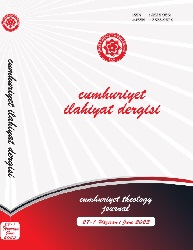10./16. Asırda Yazılmış Bir Makâlât Eseri: Fırḳa-i Nâciye Nasîrüddîn et-Tûsî ve Devvânî Üzerinden Kurtuluşa Eren Fırkanın Tespit Yöntemine Dair Polemikler
A Heresiographical Treatise Written in the 10th/16th Century: Firqa-ye Nājiya Polemics on the Method of Determining the Saved Sect through the Claims of Nasīr al-Dīn al-Ṭūsī and Jalāl al-Dīn Dawānī
Author(s): Halil IşılakSubject(s): 16th Century, History of Islam, Sociology of Religion
Published by: Cumhuriyet Üniversitesi İlahyat Fakültesi
Keywords: Islamic Theological Sects; Firqa-ye Nājiya Treatise; Twelver Shīʿīsm; Ashʿarīsm; Nasīr al-Dīn al-Ṭūsī; Jalāl al-Dīn Dawānī;
Summary/Abstract: The heresiographical literature represents a well-established writing in the tradition of Islamic thought. Although this literature has been brought to light to a significant extent, it is still possible to encounter new and original texts. As a matter of fact, the treatise named Firqa-ye Nājiya, which we came across while examining the catalogs of manuscripts on another subject, is one of them. This study examines the sources of the classification of the sects and the main interlocutors in a treatise named Firqa-ye Nājiya, which was written in Persian by a Shiite scholar in 982/1574. In this treatise, which is in the Markaz-e Iḥyāʾ-e Mīrās-e Islāmī Library and has no other copy as far as we know, it has been tried to prove that the Twelver Shiʿa is the saved sect (firqa-yi nājiya) through seventy-three sects classification. Although the text is centered on the Shiite understanding of history and creed, it presents an eclectic structure in terms of content. The author summarized seven doubts raised by the devil, the first events that caused the Muslim community (umma) to disagree, and the general information about the sects from al-Milal wa-l-niḥal, the classifications of the sects from Sharḥ al-Mawāqif, but reconstructed the data in these texts according to the Shiite understanding. On the other hand, the main reason for writing this treatise is to respond to Jalāl al-Dīn Dawānī’s claims rather than the classification of sects. Nasīr al-Dīn al-Ṭūsī determined a method for the identification of the saved sect as "differentiating from all sects in matters of theology". He claimed that the Twelver Shīʿīsm differed from the other sects in all matters of theology and was, therefore, the saved sect. Dawānī stated that Twelver Shīʿīsm differed from other sects only with the belief in imamate, which is not the subject of creed, and that it generally agrees with Mu'tazila in other creeds, thus claiming that Ṭūsī's claim is baseless. He also said that, when considered through the same method, Ashʿarīsm is more worthy of being the saved sect, because this sect differs from all sects in matters related to the creeds. Dawānī's claims found different responses in different geographies according to their sectarian affiliations. Some of the Ottoman scholars reacted to the ignoring of Māturīdiyya and confining the saved sect to Ashʿarīsm. The members of the Twelver Shīʿīsm, on the other hand, saw Dawānī's views as the main claim that needed to be refuted in proving that the saved sect was the Twelver Shīʿīsm. Shiite scholars tried to distinguish the Twelver Shīʿīsm from other sects, especially the Mu'tazila, in matters of creed, and to invalidate the famous assumption that their sect was in agreement with the Mu'tazila in creed. In order to justify this claim, some have argued that it is not the Twelver Shīʿīsm, but rather Ashʿarīsm - which was positioned as the main interlocutor in Sunnism in this period - that holds similar views to the Mu'tazila. One of the first texts in the Shiite tradition to respond to Dawānī's claims is the Firqa-ye Nājīye. In response to Dawānī, the author tried to prove that the Twelver Shīʿīsm was the saved sect through three different methods. Firstly, he stated that, contrary to Dawānī's claim, the imamate was one of the most important principles of religion and also claimed that the Twelver Shīʿīsm differed from other sects in matters of creed other than imamate. Secondly, he characterized the separation of Ashʿarīsm from other sects as a separation that is contrary to the principles of religion and reason. Thirdly, he tried to exclude Shiite sects such as the Ghulāt, Ismāʿīlīs, Kaysāniyya, and Zaydiyya, which differed from other sects by accepting imamate as a matter of theology and should have been the saved sect through this method, from the saved sect with various justifications. In fact, the theological issues mentioned by the author of the Firqa-ye Nājiya as the different views of the Twelver Shīʿīsm from other sects justify Dawānī in some respects. Because the theological views he mentions as differences other than the belief in imamate are generally compatible with the views of other sects, especially the Mu'tazila. As a matter of fact, in many places in the text, he stated that the Mu'tazila agreed with the Twelver Shīʿīsm on the theological issues in question. Probably for this reason, at the end of the treatise, when he mentions the differences of Twelver Shīʿīsm from other sects in the theological issues, he does not mention the Mu'tazila at all and does not mention what kind of differences the Twelver Shīʿīsm have with this sect except the issue of imamate.
Journal: Cumhuriyet İlahiyat Dergisi
- Issue Year: 27/2023
- Issue No: 1
- Page Range: 267-280
- Page Count: 14
- Language: Turkish

